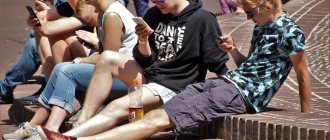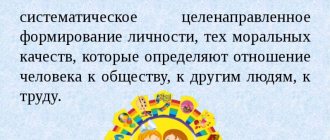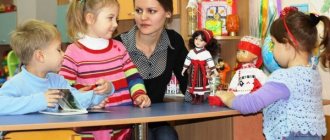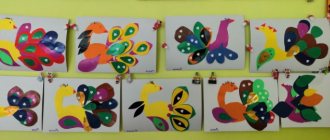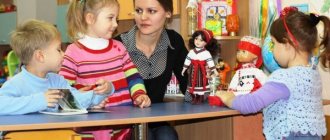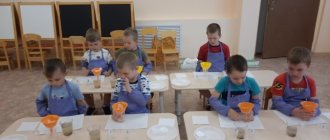The concept and essence of aesthetic education of preschool children
Definition 1
Aesthetic education is a purposeful process of influencing the personality of a preschool child, with the goal of developing his ability to see beauty in the world around him, works of art, as well as the ability to create beauty on his own.
Note 1
Aesthetic education of children must begin from the very first days of life.
Aesthetic education is a purposeful process of developing creative activity in preschool children, the ability to perceive and appreciate beauty in nature, life and art. Aesthetic education of preschool children includes instilling in children an aesthetic attitude towards social life, work, nature, art and everyday life. However, knowledge of works of art is very multifaceted, so it stands out as a separate part of the aesthetic education of children.
Are you an expert in this subject area? We invite you to become the author of the Directory Working Conditions
In the process of aesthetic education, preschool children become acquainted with the beauty in the surrounding life, nature and art, they learn to perceive and feel this beauty. This process contributes to the development of their imagination and imagination.
The system of aesthetic education for preschool children includes:
- education through artistic means;
- education through art;
- education through extra-artistic means (nature, work, environment, educational activities, etc.).
Note 2
Thus, the process of aesthetic education includes general cultural, philosophical and psychological-pedagogical education.
The purpose and objectives of aesthetic education of preschool children
The main goal of aesthetic education of preschool children is to give children the necessary knowledge, skills and abilities from various fields of art, as well as to develop their interest and desire to engage in independent creative activities.
Finished works on a similar topic
Course work Aesthetic education of preschool children 420 ₽ Abstract Aesthetic education of preschool children 270 ₽ Test work Aesthetic education of preschool children 210 ₽
Receive completed work or specialist advice on your educational project Find out the cost
Achieving the main goal of aesthetic education of preschool children is achieved through the consistent solution of a number of the following groups of tasks:
- The first group of tasks of aesthetic education are tasks aimed at developing in children an aesthetic attitude towards the world around them and their acquisition of theoretical knowledge. Includes a number of the following tasks:
- education of aesthetic culture in children;
the formation and development of aesthetic perceptions, feelings and experiences, as well as an aesthetic attitude towards the activities surrounding the child;
- developing in children the ability to see and feel beauty in actions, nature, art, and the world around them;
- cultivate the need for knowledge of beauty;
- nurturing the desire to surround yourself with beauty, to create it with your own hands.
- The second group of tasks of aesthetic education of preschool children is the formation in children of practical skills in the field of various types of arts. Includes:
- teaching children to sculpt, draw, design, sing, and move to music;
formation and development of oral creativity.
Aesthetic education of preschool children within the preschool educational institution involves solving the following problems:
- Carrying out the systematic development of the perception of beauty and aesthetic feelings of children, through various types of arts, activities, emotional involvement, etc.
- Introducing children to art, teaching them practical skills, educating them to bring elements of beauty into the environment as much as possible.
- Formation in children of aesthetic taste and the ability to independently evaluate works of art and life phenomena.
- Development of children's creative and artistic abilities through the organization of activities related to art.
MAGAZINE Preschooler.RF
Conditions, means and role of the teacher in the aesthetic education of childrenAesthetic education is one of the areas of pedagogy, the main goal of which is to teach a person to understand and appreciate beauty. A.P. Chekhov said: “Everything in a person should be beautiful: face, clothes, soul, and thoughts . In order for a person to create beauty in himself and around him, he must first of all learn to hear, see, understand, and most importantly, feel beauty. Translated into Greek, feel and sensual will be the word aesthetics. Hence the concept of aesthetic education as the education of sensuality. Aesthetic education of preschoolers is a process through which the child develops the ability to notice the beauty of the environment, love art and be involved in it. The influence on the child’s personality begins from the first year of his life; it must be targeted and systematic.
The goal of aesthetic education is to teach a child to see and understand the beauty around him.
Cultivating a sense of beauty is not limited to artistic and musical perception. This is a whole system that includes the child’s attitude to social work and life, to everyday life and nature.
The role of aesthetic education in child development
From the first days of life, a child is attracted to bright shiny toys and objects, colorful colors and attractive elements. Satisfied interest gives them a feeling of joy and pleasure. The concept of “beautiful” is recognized by the child very early. Listening to fairy tales or songs, looking at pictures and toys, they get a lot of positive emotions and experiences. These unconscious impulses, in the process of aesthetic education and development of preschool children, gradually transform into a conscious perception of beauty. The task of adults is to form the foundations of harmonious taste, develop the artistic and creative abilities of preschool children, their aesthetic feelings and ideas.
Aesthetic education is an important aspect of the full development of a child, because it promotes:
- Development of the emotional and sensory sphere;
- The child’s sensory culture is formed (children listen to the sounds of the forest, birdsong, rustling leaves; examine the beauty and color of trees; inhale the aromas of flowers, meadows, fields);
- Aesthetic ideas about actions and behavior patterns are formed;
- Aesthetic education enhances: mental education (imagination, auditory and visual memory develops, knowledge about folk arts and music expands; physical education (music, artistic expression, colorful paraphernalia contribute to the formation of tempo, rhythm of movements, plasticity, positive attitude towards physical culture) ; moral education, because in the beauty of nature and art lies the greatest educational force, which forces the child to observe the rules of respect for nature and the environment.
The means of aesthetic education of children are objects and phenomena of the surrounding reality selected by the teacher and specially organized for the education of children. These include:
- Aesthetics of everyday life means teaching a child to see beauty in the ordinary (beautiful curtains, napkins, toys, furniture). If the environment is aesthetic, beautiful (not necessarily rich), if the child sees beautiful relationships between people, hears beautiful speech, there is reason to hope that from an early age he will accept an aesthetic environment as the norm. Three rules that make everyday aesthetics a means of aesthetic education: live in beauty, notice beauty, maintain and create beauty around you.
- Works of art. They are used in the design of everyday life, during training, and in independent activities. For this purpose, they select works of everyday and fairy-tale painting (portraits, still lifes, landscapes), graphics (prints, engravings, book illustrations), small forms of sculpture (faience, plaster, wood), works of folk applied art (ceramics, glass, folk decorative items, etc...)
- Nature. Growing up among nature, a child learns to see the harmony, beauty, and richness of colors of each season, and to reproduce his impressions in oral stories, drawings, etc. All this is accompanied by the teacher’s stories that nature is a powerful and perfect creator of beauty; painters, composers, and writers draw inspiration from it. 4.Special training. The formation of ideas about beauty, skills in artistic and creative activity, and the development of aesthetic assessments are facilitated by special training for preschoolers in kindergarten. To do this, I use various types of classes, artistic and didactic games, holidays, matinees, excursions, walks, watching performances, presentations, etc.
- Holidays. They are associated with children’s vivid aesthetic experiences, desires to test themselves in different genres of art, and performances in colorful costumes. Preparing for the holiday, children's participation in creating performances, and anticipation of the festive action form a special pre-holiday collective mood.
- Independent artistic activity of children. It is an important means of aesthetic education of preschool children. In the process of artistic activity, they realize their creative ideas, inclinations, which can subsequently develop into the ability for artistic creativity. To develop independent artistic activity, special centers are created with the necessary equipment and materials that children can use freely. The teacher takes care of the variety of children’s activities, the combination of different types of artistic activities: visual, artistic and speech, theatrical and playful, musical. 7. A museum, cinema, and cultural center can play a significant role in aesthetic education. Visiting cultural centers also forms the first skills of artistic and aesthetic perception in childhood. The basis of the process of aesthetic education is the activity of the teacher and the child, aimed at developing his abilities to perceive beauty, artistic values and productive activity. The personality of the teacher also plays an important role in the aesthetic education of preschoolers. The teacher himself must be an example of moral behavior and be a well-rounded personality, since the child relies on his own feelings and emotions. It is necessary to competently select the content of the proposed material and determine it in accordance with the age and individual capabilities of preschoolers. Also, it is necessary to introduce into joint activities special methodological actions and techniques that ensure active and meaningful assimilation of knowledge and skills. The teacher introduces to the beautiful, encourages empathy, emotional responsiveness to the beauty in the world around us.
The key role of a kindergarten is to create conditions for the formation of a harmoniously, intellectually developed personality.
- Creation of an aesthetic subject-development environment: beauty and cleanliness in the group, harmonious combination of colors of curtains, walls, bedspreads in the bedroom; aesthetic thoughtfulness of furniture and equipment.
- Saturation of groups with objects of art: paintings, panels, vases, objects of folk and applied arts.
- Presence of book, art, theater and music centers in the group.
- It is necessary to monitor the external appearance of the people around you: the teacher, junior teacher and other employees of the preschool institution (beautiful, neat, good manners of behavior and communication).
- It is necessary that the groups have corners of nature, on the street - a vegetable garden, flower beds, green spaces.
- It is necessary to hold holidays and entertainment for children and parents with music, poetry, skits, and dances.
In our group, conditions have been created for the aesthetic education of children. Created (slide) for a variety of artistic activities, in which children engage both under the guidance of teachers and on their own initiative. For creative activity, it is very important that the environment surrounding the child is beautiful, cozy, and comfortable at home. This liberates the child and encourages creativity. It is important not only to feel, but also to create something beautiful. Children are given the opportunity to draw, sculpt, and appliqué at any time, using different materials. The creativity center has a lot of step-by-step educational samples, visual aids, and stencils. We organize the introduction of children to decorative activities: (slide) we consider elements of decorative painting, silhouettes of folk toys, nesting dolls, thematic coloring books “Getting to Know Painting” , children love to play games such as “Learn the Painting” , “Find the Similarities and Differences of Folk Costumes” " , "What's superfluous" , etc. We got acquainted with the products of folk craftsmen, watched presentations on the creation of Russian and Vyatka nesting dolls. (slide)
We are trying to conduct more non-traditional art activities using different drawing techniques and materials (this is drawing with pokes, cotton swabs, drawing with fingers, (slide) scratching with stacks, drawing with salt, printing with a sponge, blowing a drawing from a “Blotography” , (we took part in the All-Russian competition "Blotography" . We use materials such as special stencils for glass, (slide) plaster figures, colored crayons, washable markers, wooden blanks. For modeling classes we use various waste materials, rainbow sand (slide), clay. The use of such techniques and methods develop children's imagination and creative imagination. We display the best works in a group on the "Beauty Shelf" . (slide) We teach children to use means of artistic expression (poems, proverbs, sayings, excerpts from works). Music plays an important role in the aesthetic education of children -theatrical activity. Music has a sound nature, a generalization of images, being “the art of feelings ,” as P.I. said. Chaikovsky. We try to make music sound not only in music classes, but also in everyday life, in children’s games, during exercises, and in other types of activities. The group has created a musical and theatrical center (slide), in which children enjoy playing musical instruments, (slide) participate in the dramatization of fairy tales, (slide) performances, and dramatizations. We use various types of theaters: finger theater, magnetic theater, bibabo toys, etc. d.
To enrich emotional and sensory perception, each group has conditions for introducing children to fiction. In the book center (slide) there are portraits of writers, necessary selections of literature to introduce children to them, their works, fairy tales, and folklore.
The leading place in the artistic and aesthetic development of children belongs to kindergarten. But the role of the family is also great. The result of such activities is the participation of students with their parents in competitions at the district and regional levels. Nikita Gorin took first place in the regional competition “Winter's Tale” with the craft “At the edge of the forest, winter lived in a hut . Only with the unity of the influence of the kindergarten and the family is it possible to fully implement the tasks of aesthetic education. Not every child will become a musician, artist, or writer, but every child can and should develop a love and interest in art, develop aesthetic taste, an ear for music, and basic drawing skills.
Thus, a properly organized system of work on the artistic and aesthetic education of children, the creation of conditions for aesthetic education, the organization of the educational process will create favorable conditions for the development of children’s artistic and aesthetic abilities, creative imagination and, as a result of aesthetic education, a spiritually rich , a comprehensively developed personality.
Dear teachers!
Let's cultivate in our children a sense of beauty and aesthetic perception, because this is so necessary in our time.
| Next > |
